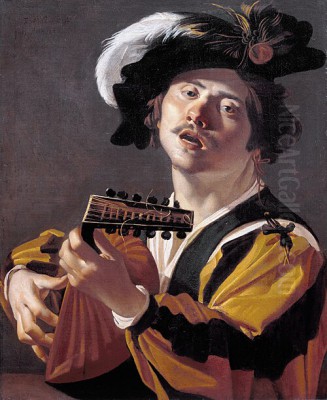
Dirck Jaspersz. van Baburen, a name that resonates with the vibrant artistic energy of the Dutch Golden Age, stands as a pivotal figure in the transmission of Caravaggism to Northern Europe. Though his career was tragically short, his impact was profound, particularly as a leading member of the Utrecht Caravaggisti. His works, characterized by dramatic lighting, earthy realism, and a penchant for lively, often boisterous, genre scenes, offer a fascinating window into the cultural and artistic exchanges of the early 17th century.
Early Life and Artistic Genesis in Utrecht
Born around 1595, likely in Wijk bij Duurstede near Utrecht, Dirck van Baburen's early life is somewhat shrouded in the mists of time, a common fate for many artists of his era before detailed record-keeping became more systematic. However, it is firmly established that his formative artistic training took place in Utrecht, a city that, despite the predominantly Protestant character of the Dutch Republic, retained significant Catholic enclaves and a strong connection to Italian artistic traditions.
His primary teacher was Paulus Moreelse (c. 1571–1638), a respected Utrecht painter known for his portraits, historical scenes, and idyllic pastoral landscapes. Moreelse himself had studied in Italy, absorbing influences from the late Renaissance and early Baroque. Under Moreelse, Baburen would have received a solid grounding in drawing, composition, and the handling of paint, likely working on religious and mythological subjects that were part of the standard academic repertoire. This apprenticeship, probably starting in the late 1600s or early 1610s, laid the essential groundwork for his later, more radical stylistic developments. Utrecht, at this time, was already a burgeoning artistic center, with artists like Abraham Bloemaert also active, fostering a rich environment for young talents.
The Italian Pilgrimage: Immersion in Caravaggio's World
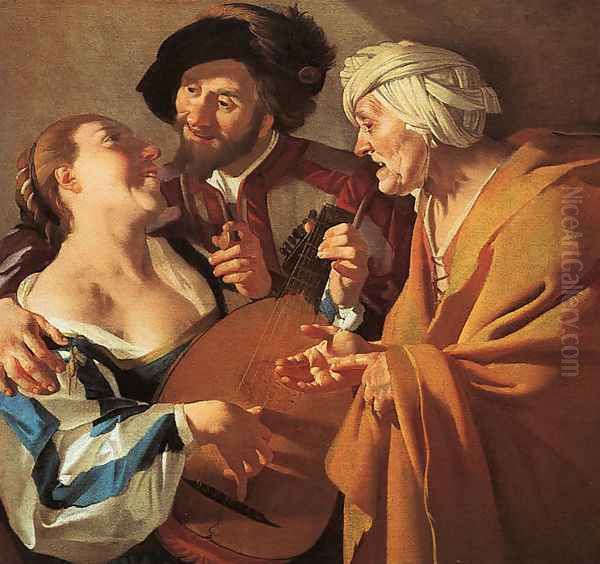
Around 1612, following a path trodden by many ambitious Northern European artists, Dirck van Baburen embarked on the transformative journey to Italy, the undisputed center of the art world. Rome, in particular, was a magnet, still pulsating with the revolutionary artistic energy unleashed by Michelangelo Merisi da Caravaggio (1571–1610) just a few years prior. Though Caravaggio himself was deceased by the time Baburen arrived, his dramatic use of chiaroscuro (strong contrasts between light and dark), his unidealized, naturalistic depiction of figures, often drawn from common life, and the raw emotional intensity of his narratives had irrevocably altered the course of painting.
In Rome, Baburen quickly fell under the spell of Caravaggio and his followers, the so-called Caravaggisti. He associated with other artists, both Italian and Northern European, who were exploring this new, powerful mode of expression. Among these were prominent figures like Bartolomeo Manfredi (c. 1582–1622), who was instrumental in popularizing Caravaggesque genre scenes of taverns, musicians, and fortune-tellers. He also encountered the work of the Spanish master Jusepe de Ribera (1591–1652), known for his stark realism and dramatic religious paintings, and possibly Carlo Saraceni (c. 1579–1620), another key Caravaggist.
During his Roman sojourn, which lasted until about 1620, Baburen was not merely a passive observer. He actively sought and received significant commissions. He collaborated with fellow Netherlandish artist David de Haen on decorations for the Pietà chapel in the church of San Pietro in Montorio. More prestigiously, he secured commissions from important patrons, including Vincenzo Giustiniani and Cardinal Scipione Borghese, both renowned collectors with a taste for Caravaggio's art. Perhaps his most notable Roman commission was for the high altarpiece of San Pietro in Montorio, The Entombment of Christ, a powerful and moving work that clearly demonstrates his mastery of the Caravaggesque idiom.
The Utrecht Caravaggisti: A Northern Bastion of Tenebrism
Around 1620 or 1621, Dirck van Baburen returned to his native Utrecht, his artistic vision profoundly shaped by his years in Italy. He did not return in isolation; around the same time, other Utrecht painters who had also been captivated by Caravaggio's style, notably Hendrick ter Brugghen (1588–1629) and Gerrit van Honthorst (1592–1656), also made their way back. Together, these three artists became the leading figures of what is known as the Utrecht Caravaggisti.
This group was unique in the Dutch Republic. While artists in other Dutch cities like Amsterdam or Haarlem were developing distinct styles focused on portraiture, landscape, and meticulously detailed domestic scenes, the Utrecht Caravaggisti brought a bold, dramatic, and often monumental style heavily indebted to Italian art. Utrecht's relatively strong Catholic presence and its historical ties to Rome made it a more receptive environment for these large-scale religious and mythological paintings, as well as the lively, sometimes risqué, genre scenes popularized by Caravaggio's followers.
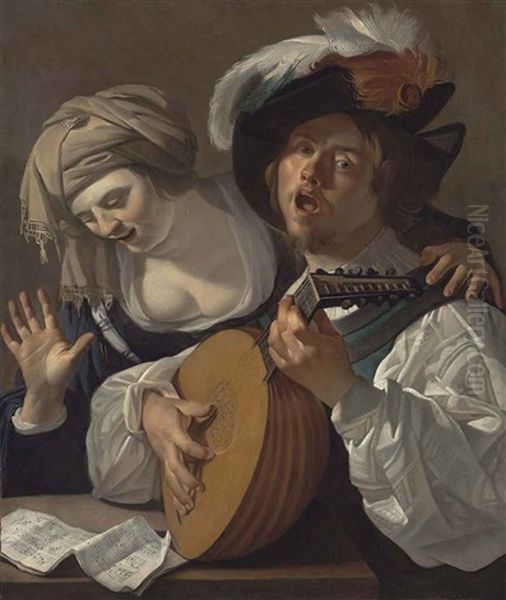
Baburen and Ter Brugghen are known to have shared a studio for a period, likely between 1622 and 1623, fostering a close artistic dialogue. While both were committed to Caravaggesque principles, their individual styles retained distinct characteristics. Van Honthorst, known as "Gherardo delle Notti" (Gerard of the Night Scenes) for his mastery of artificial light sources like candles and torches, achieved considerable international fame. The collective output of these artists made Utrecht a vibrant center for this particular strand of Baroque art, influencing a subsequent generation of Dutch painters.
Baburen's Distinctive Style: Realism, Drama, and Earthy Vitality
Dirck van Baburen's artistic style is a compelling fusion of Caravaggio's dramatic naturalism and a distinctly Northern European sensibility. His paintings are immediately recognizable for their powerful use of tenebrism, where figures emerge dramatically from dark, undefined backgrounds, illuminated by a strong, often raking, light source. This technique not only created a sense of theatricality but also served to model forms with a palpable sense of volume and presence.
His figures are typically robust and earthy, far removed from the idealized beauty of the High Renaissance. Baburen, like Caravaggio, did not shy away from depicting wrinkles, calloused hands, and individualized, often unrefined, facial features. This commitment to realism extended to the emotional content of his work; his figures convey a raw, unvarnished humanity, whether in moments of profound religious devotion, boisterous revelry, or quiet contemplation.
In his genre scenes, Baburen often depicted musicians, drinkers, and figures from the demi-monde, such as procuresses and courtesans. These works are characterized by a lively energy, crowded compositions, and a focus on expressive gestures and interactions. His palette, while often dominated by strong contrasts of light and dark, could also incorporate rich, vibrant colors, particularly in the depiction of fabrics and costumes. He favored half-length or three-quarter-length figures, bringing the viewer into close proximity with the scene and enhancing its immediacy. This approach was common among the Caravaggisti, including artists like Valentin de Boulogne (c. 1591–1632), a French painter active in Rome.
Key Masterpieces: A Closer Look
Dirck van Baburen's relatively short career yielded a significant body of work, with several paintings standing out as iconic examples of his style and contribution to the Utrecht Caravaggisti movement.
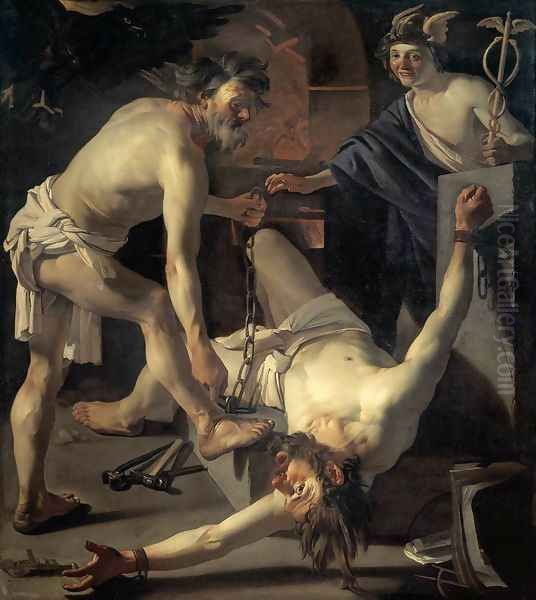
The Entombment of Christ (c. 1617-1619, San Pietro in Montorio, Rome): This altarpiece, created during his Roman period, is a testament to Baburen's early mastery of Caravaggesque drama. The composition is dynamic, with the heavy body of Christ being lowered into the tomb, his pallid flesh starkly contrasted against the deep shadows and the rich reds and blues of the mourners' robes. The grief of the figures, particularly Mary and John the Evangelist, is palpable, rendered with an emotional intensity that directly engages the viewer. The strong diagonal lines and the focused illumination heighten the scene's tragic power. This work directly echoes Caravaggio's own famous Entombment (Vatican Museums), showcasing Baburen's ambition to emulate the master.
The Procuress (1622, Museum of Fine Arts, Boston): This is perhaps Baburen's most famous genre painting and a quintessential example of Utrecht Caravaggism. The scene depicts a young woman, a lute player, negotiating with an older procuress while a young man offers a coin. The figures are pressed close together, filling the canvas, and illuminated by a strong light that highlights their expressive faces and gestures. The painting is notable for its vibrant colors, the tactile rendering of fabrics, and its frank depiction of a transactional encounter. Interestingly, a version of this painting (or a copy) was owned by Johannes Vermeer's mother-in-law and appears in the background of two of Vermeer's own paintings, The Concert and Lady Seated at a Virginal, attesting to Baburen's lasting influence.
Christ Crowned with Thorns (c. 1622-1623, Museum Catharijneconvent, Utrecht, and another version in the Nelson-Atkins Museum of Art, Kansas City): In this powerful religious scene, Baburen focuses on the physical and emotional suffering of Christ. The figures of the tormentors are brutish and muscular, their actions cruel, while Christ's expression is one of pained resignation. The dramatic lighting emphasizes Christ's pale skin and the crown of thorns, creating a visceral sense of his agony. The close-up, half-length format intensifies the viewer's engagement with the scene, a hallmark of Caravaggesque religious painting as practiced by artists like Orazio Gentileschi (1563–1639) and his daughter Artemisia Gentileschi (1593–c. 1656).
Lute Player (c. 1622, Centraal Museum, Utrecht): Baburen painted several versions of musicians, particularly lute players, a popular theme among the Caravaggisti. These works often feature a single, engaging figure, directly addressing the viewer, sometimes with a songbook open. The Lute Player in Utrecht is a fine example, showcasing Baburen's skill in capturing a lively expression and the textures of costume and instrument. These works highlight the secular side of Utrecht Caravaggism, appealing to a broader market of art collectors. Such depictions of musicians were also a specialty of his contemporary Hendrick ter Brugghen.
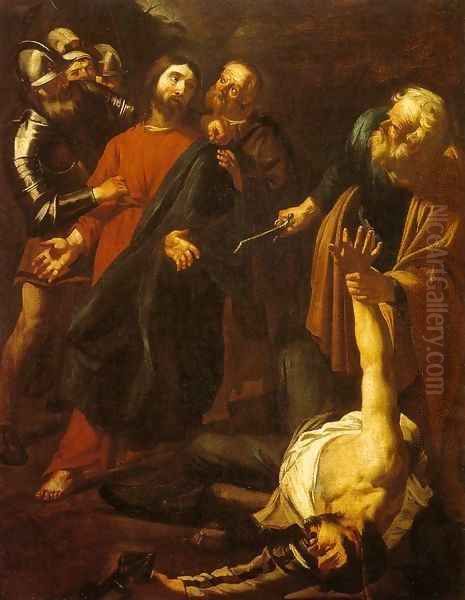
Vulcan Chaining Prometheus (1623, Rijksmuseum, Amsterdam): This mythological scene demonstrates Baburen's ability to handle complex, multi-figure compositions with dramatic flair. The muscular figures of Vulcan and his assistants strain as they bind Prometheus, whose anguished face is a focal point. The play of light across their bodies and the dynamic poses create a sense of intense physical exertion and suffering. The subject matter, drawn from classical mythology, was also popular in Baroque art, treated by masters like Peter Paul Rubens (1577–1640) in Flanders, though Baburen's interpretation is distinctly Caravaggesque in its raw power and dramatic lighting.
Collaborations, Contemporaries, and Artistic Milieu
Dirck van Baburen was an active participant in the artistic communities of both Rome and Utrecht. His collaboration with David de Haen in Rome on the San Pietro in Montorio decorations is a documented instance of teamwork. His sharing of a studio with Hendrick ter Brugghen in Utrecht suggests a close working relationship and mutual influence. While Ter Brugghen's style often exhibits a more subtle and lyrical quality, with a cooler palette, both artists shared a commitment to Caravaggesque principles of realism and dramatic lighting.
Gerrit van Honthorst, the third major figure of the Utrecht Caravaggisti, achieved perhaps the greatest international success, his "night scenes" becoming highly sought after by patrons across Europe, including King Charles I of England. While Baburen, Ter Brugghen, and Honthorst were the core of the movement, other Utrecht artists, such as Jan van Bijlert (1597/98–1671), also adopted elements of the Caravaggesque style, though often softening its dramatic intensity in later works.
Beyond Utrecht, the influence of Caravaggism was felt, albeit sometimes indirectly, by other Dutch artists. The dramatic lighting and realistic portrayal of figures seen in the works of the Utrecht painters may have contributed to the broader development of Dutch Baroque art. Even artists with vastly different sensibilities, like Frans Hals (c. 1582/83–1666) in Haarlem, known for his lively and spontaneous portraits and genre scenes, shared a commitment to capturing the vitality of everyday life, a trait also found in Baburen's secular works. The young Rembrandt van Rijn (1606–1669), though never visiting Italy, was likely exposed to Caravaggism through prints and the works of Utrecht painters like Pieter Lastman (who taught Rembrandt and had been to Italy), which informed his own mastery of chiaroscuro.
Untimely Demise and Lasting Legacy
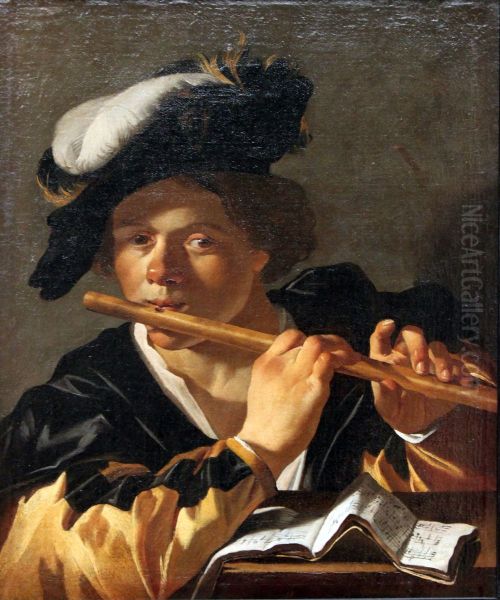
Tragically, Dirck van Baburen's promising career was cut short. He died in Utrecht on February 21, 1624, at the young age of about 29. The cause of his death is not definitively known, though some speculate it may have been due to the plague, which periodically ravaged European cities. His death, followed by Ter Brugghen's in 1629, marked a turning point for the Utrecht Caravaggisti. While Honthorst continued to be successful, his style gradually moved away from strict Caravaggism towards a more classical, courtly manner.
Despite his brief lifespan, Dirck van Baburen made a significant contribution to Dutch art. He was a key conduit for the transmission of Caravaggio's revolutionary style to the North, adapting it with a vigor and earthiness that was distinctly his own. His religious paintings possess a raw power and emotional directness, while his genre scenes offer a vibrant, unvarnished glimpse into 17th-century life.
His influence, as noted, extended to Johannes Vermeer (1632–1675), whose inclusion of Baburen's The Procuress in his own paintings is a direct acknowledgment of the older master's impact. This suggests that Baburen's work continued to be appreciated and collected in the Netherlands well after his death. While the intense phase of Caravaggism in Utrecht was relatively short-lived, its emphasis on realism, dramatic lighting, and engaging subject matter left an indelible mark on the trajectory of Dutch Golden Age painting. Artists like Judith Leyster (1609–1660), a contemporary of Hals in Haarlem, also produced lively genre scenes with strong lighting that show an affinity with the Caravaggesque spirit.
Historical Evaluation and Scholarly Reception
For a long time, Dirck van Baburen, like many of the Utrecht Caravaggisti, was somewhat overshadowed by the towering figures of Rembrandt, Vermeer, and Hals. However, 20th and 21st-century art historical scholarship has led to a significant re-evaluation of his importance. Scholars have meticulously reconstructed his oeuvre, clarified his biography, and analyzed his stylistic development and influence.
The pioneering work of art historians like Benedict Nicolson and later scholars such as Leonard J. Slatkes and Wayne Franits (whose 2013 catalogue raisonné is a definitive study) has firmly established Baburen's position as a major figure in Dutch Baroque art. Exhibitions dedicated to the Utrecht Caravaggisti have further brought their work to a wider public, highlighting their unique contribution to the European art scene.
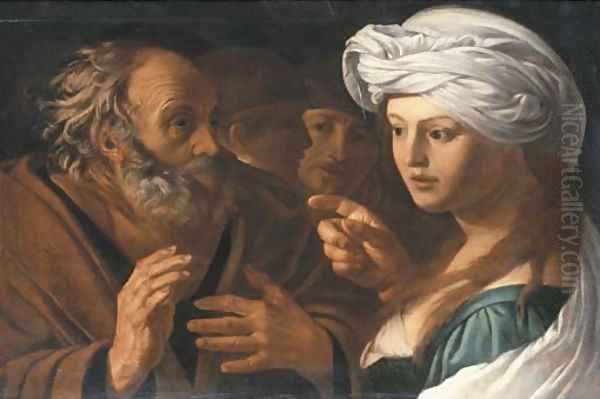
While some earlier critics may have found his style occasionally "coarse" or lacking the refined elegance of some of his contemporaries, modern appreciation tends to focus on the strength, vitality, and directness of his art. His unidealized figures and bold compositions are now seen as powerful expressions of a particular artistic vision, one that embraced the raw immediacy of Caravaggio's revolution and infused it with a Northern European sensibility. His ability to convey intense emotion, whether in sacred or secular subjects, remains compelling.
Conclusion: An Enduring Light from a Brief Career
Dirck van Baburen's life may have been brief, but his artistic flame burned brightly. As a leading member of the Utrecht Caravaggisti, he played a crucial role in introducing and popularizing a dramatic, realistic, and emotionally charged style of painting in the Netherlands. His works, from the powerful altarpieces created in Rome to the lively genre scenes painted in Utrecht, showcase a distinctive artistic personality characterized by bold compositions, strong chiaroscuro, and an unflinching portrayal of humanity. He stands as a vital link in the chain of artistic influence that stretched from Caravaggio's Italy to the heart of the Dutch Golden Age, leaving behind a legacy that continues to captivate and engage viewers centuries later. His art reminds us that even a short career, if pursued with passion and talent, can cast a long and enduring light.